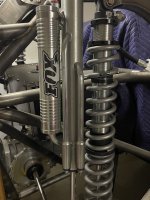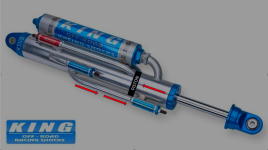All of the nitrogen is on top of the piston in the reservoir and just keeps the fluid under pressure. As the shock compresses the shaft displaces fluid and it goes into the wet bottom side of the reservoir. Changing the nitrogen pressure does change the stiffness of the shock in general but not because of the valving but rather because of the more or less resistance of fluid trying to move into the reservoir. Using the valving and/or bypass tubes is how the shock was engineered to dampen shaft movement not the pressure above the floating piston. If you want more dampening give the bypass adjusters another half or full turn at a time and retest, and which ones to adjust depends on if you want more compression or rebound dampening, bypass tubes are typically set up with the longest compression tube being near closed to act as a bump stop when it's near the end of it's travel. A good way to determine if your car needs adjustment is to film it driving over whoops and then go back and look at the video, you can get a good idea where an improvement can be made if you find the back wheels buck over the tops of whoops, you need more rebound dampening to slow the suspension movement down. Just the opposite on the compression if it rides harshly. I'm far from a suspension guy but I've played with mine enough to know what the tubes do.
And I do not like the idea of removing valving from the coil over shock, it places all of the dampening responsibility on the bypass and overheats the fluid unnecessarily.



